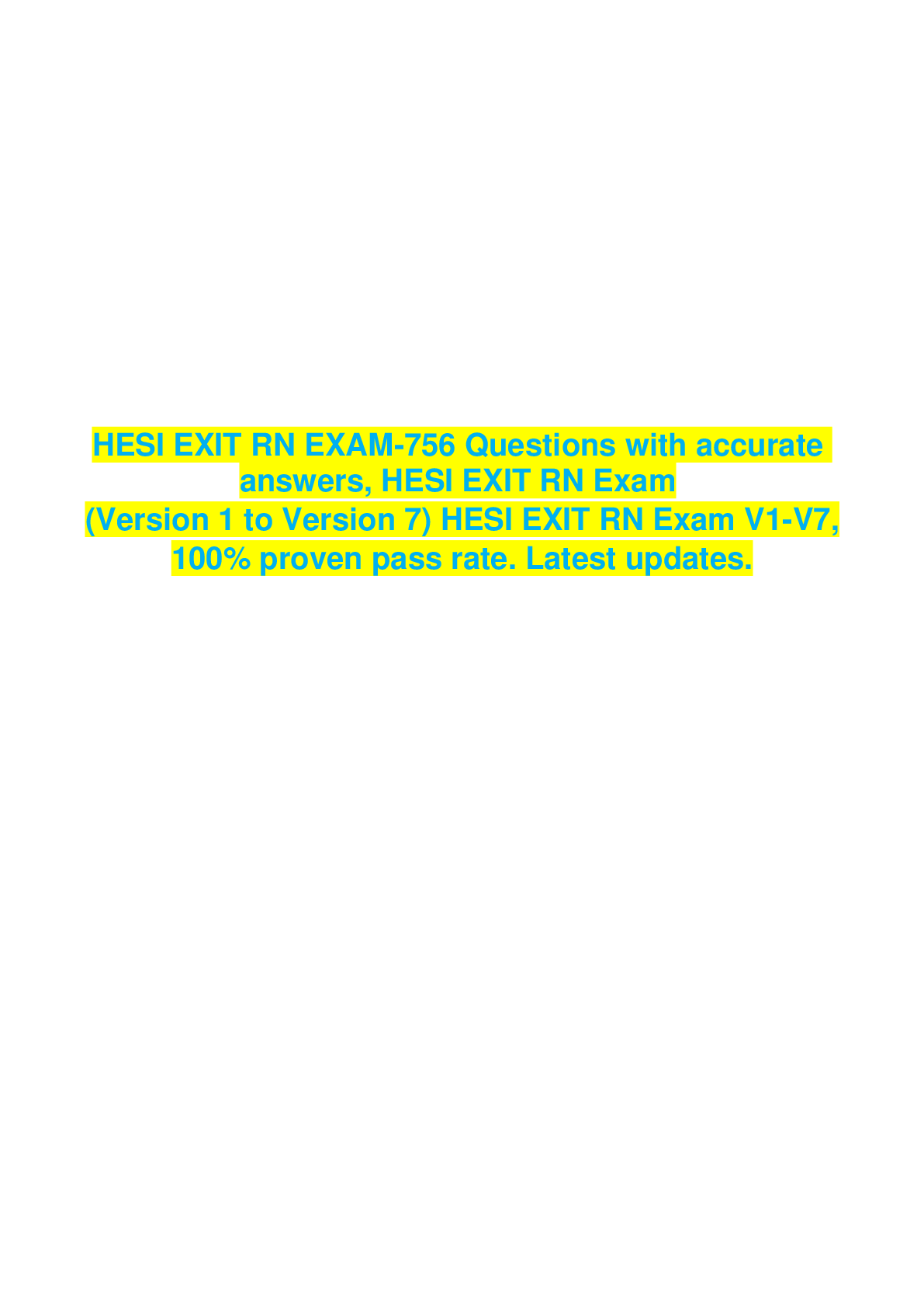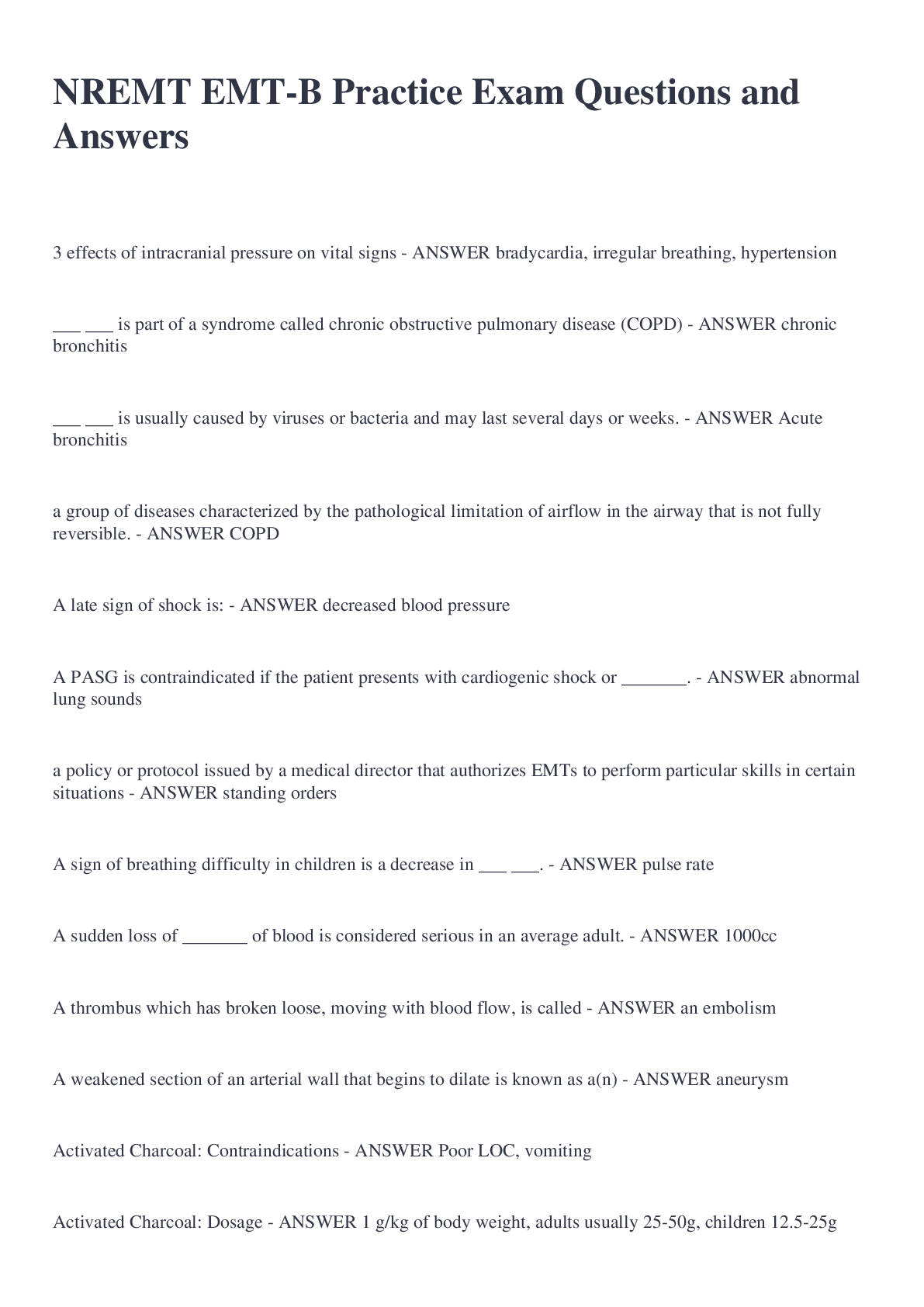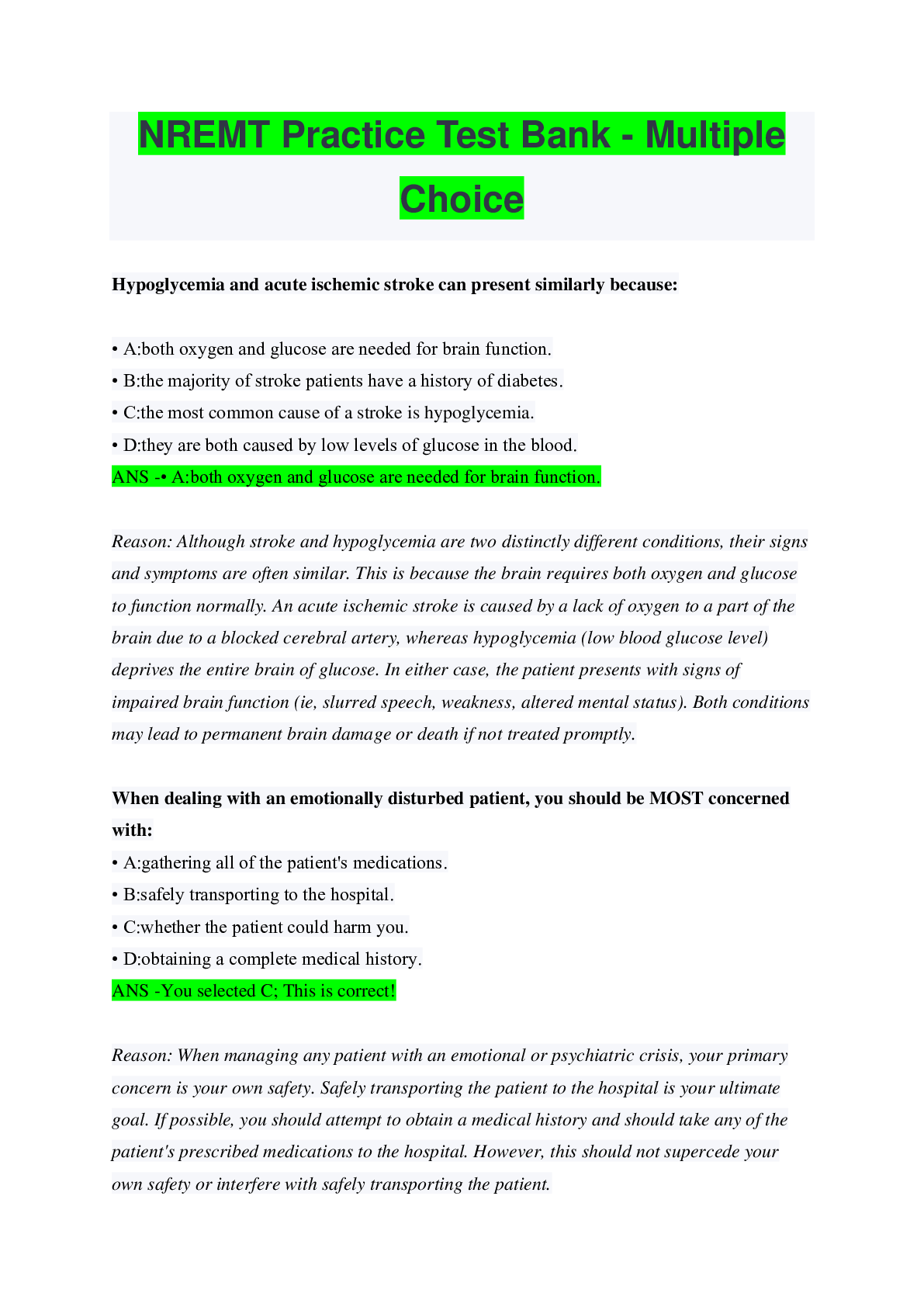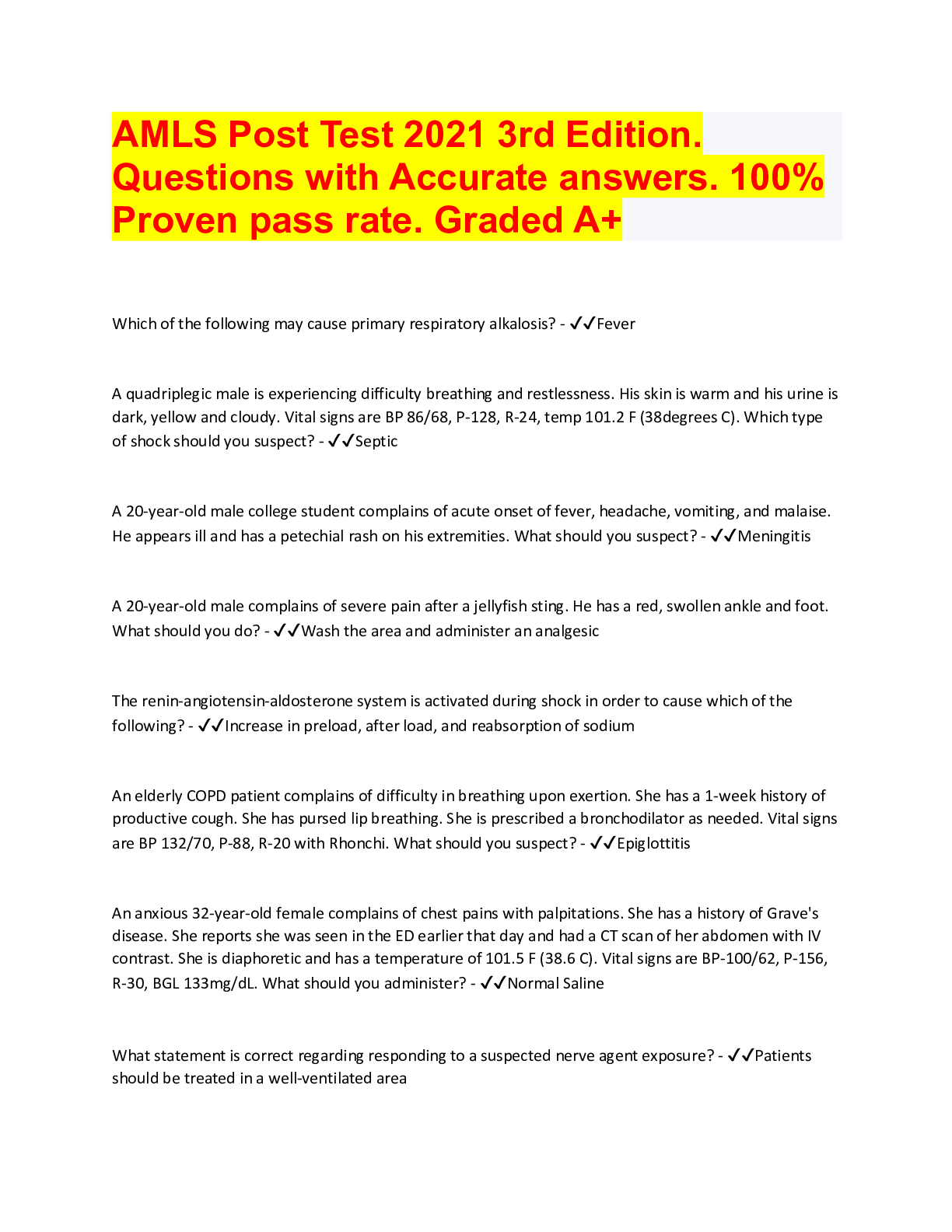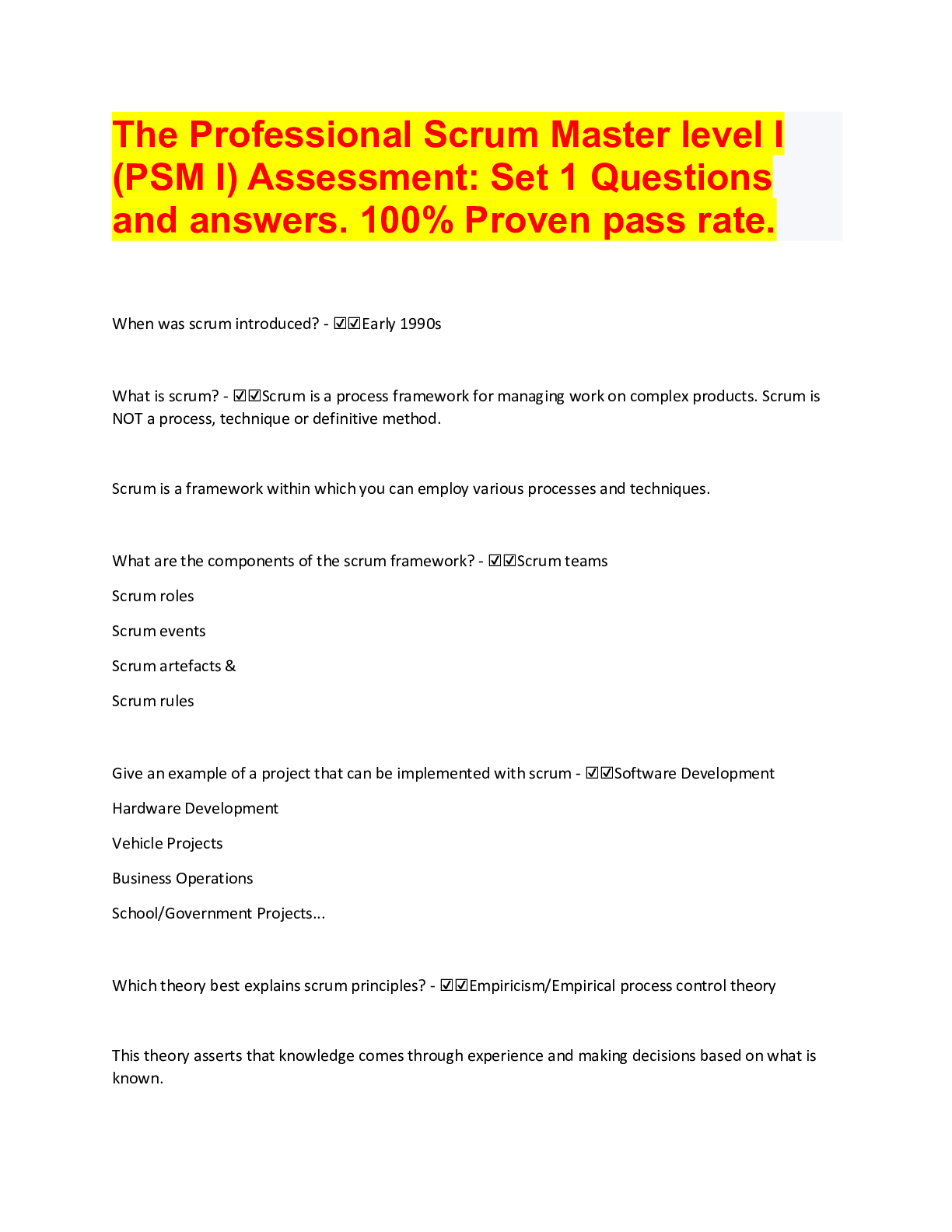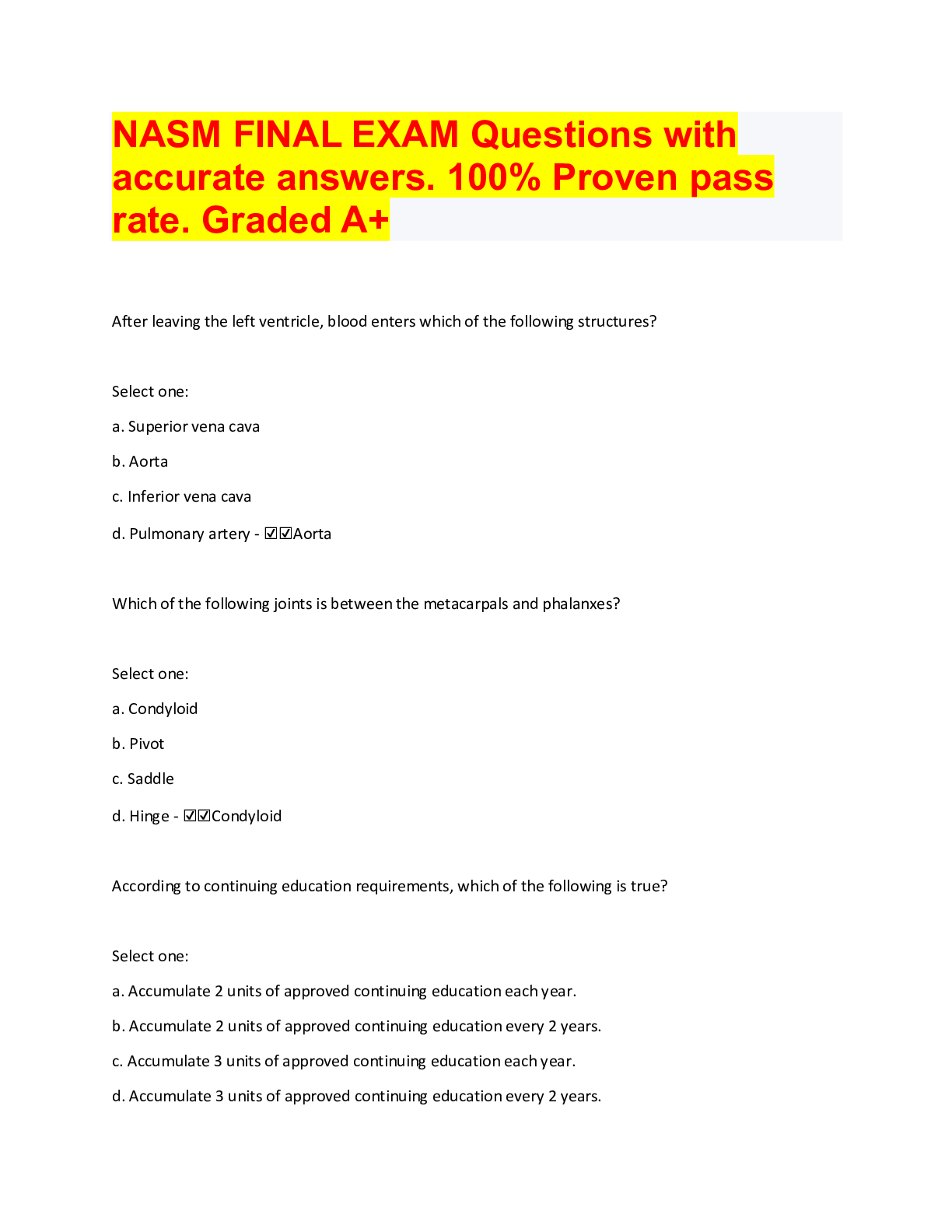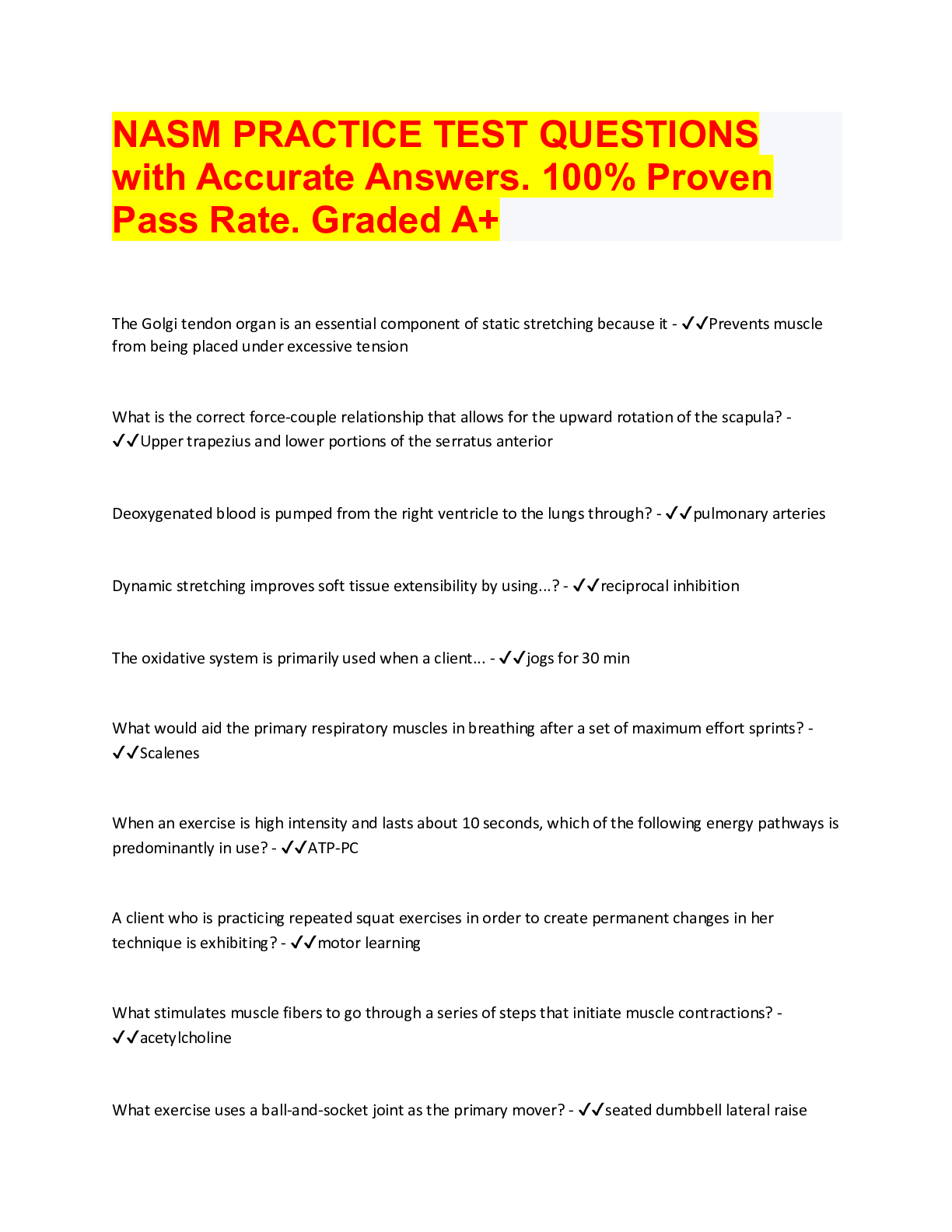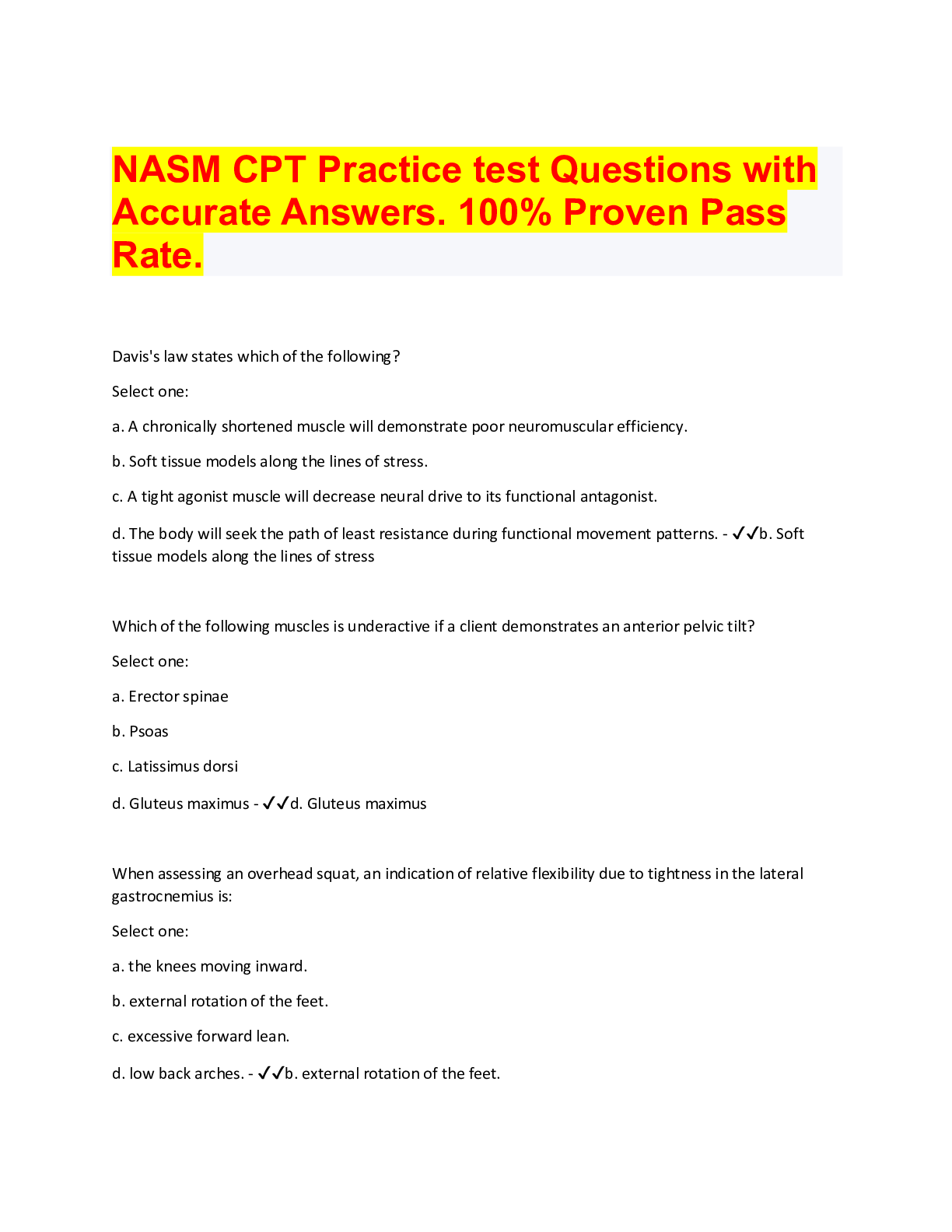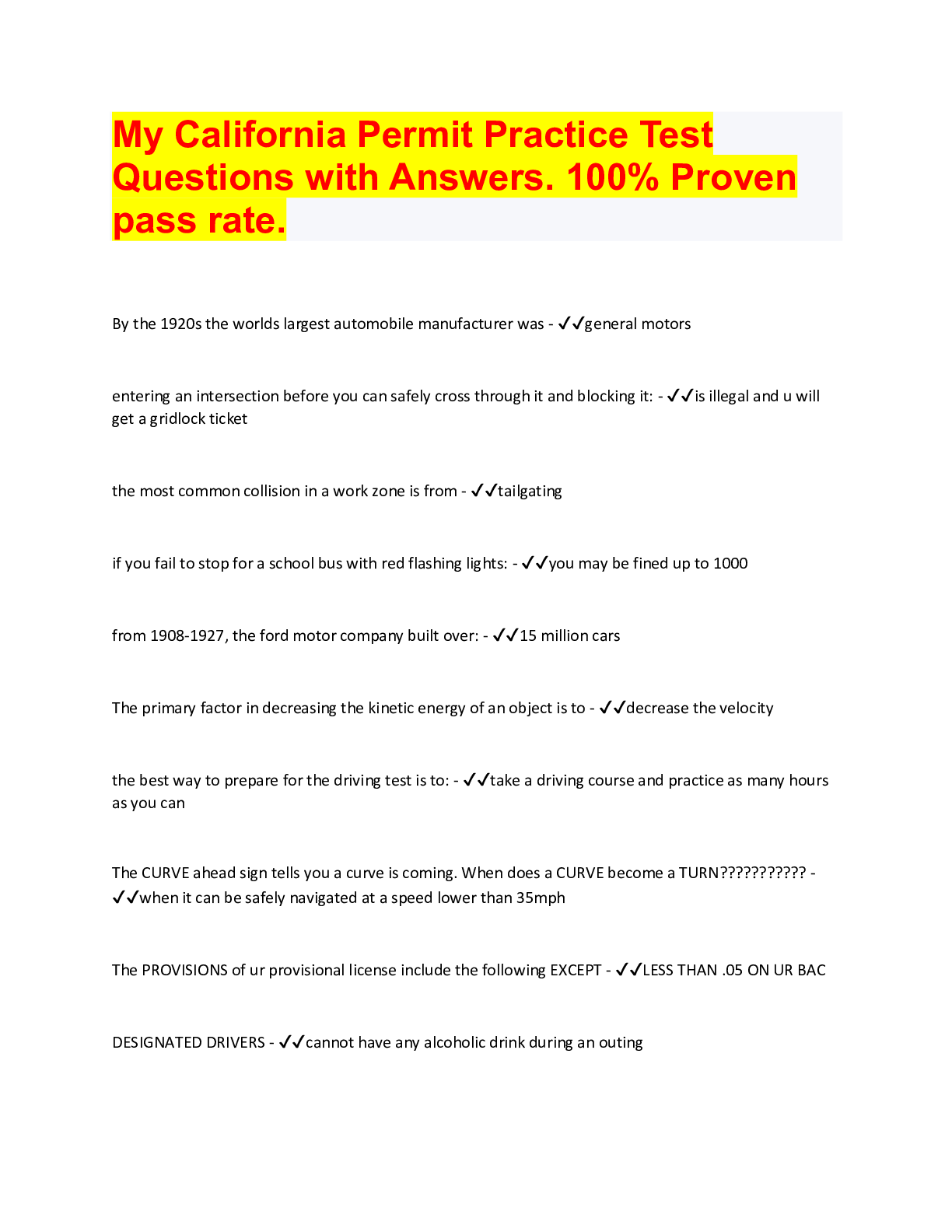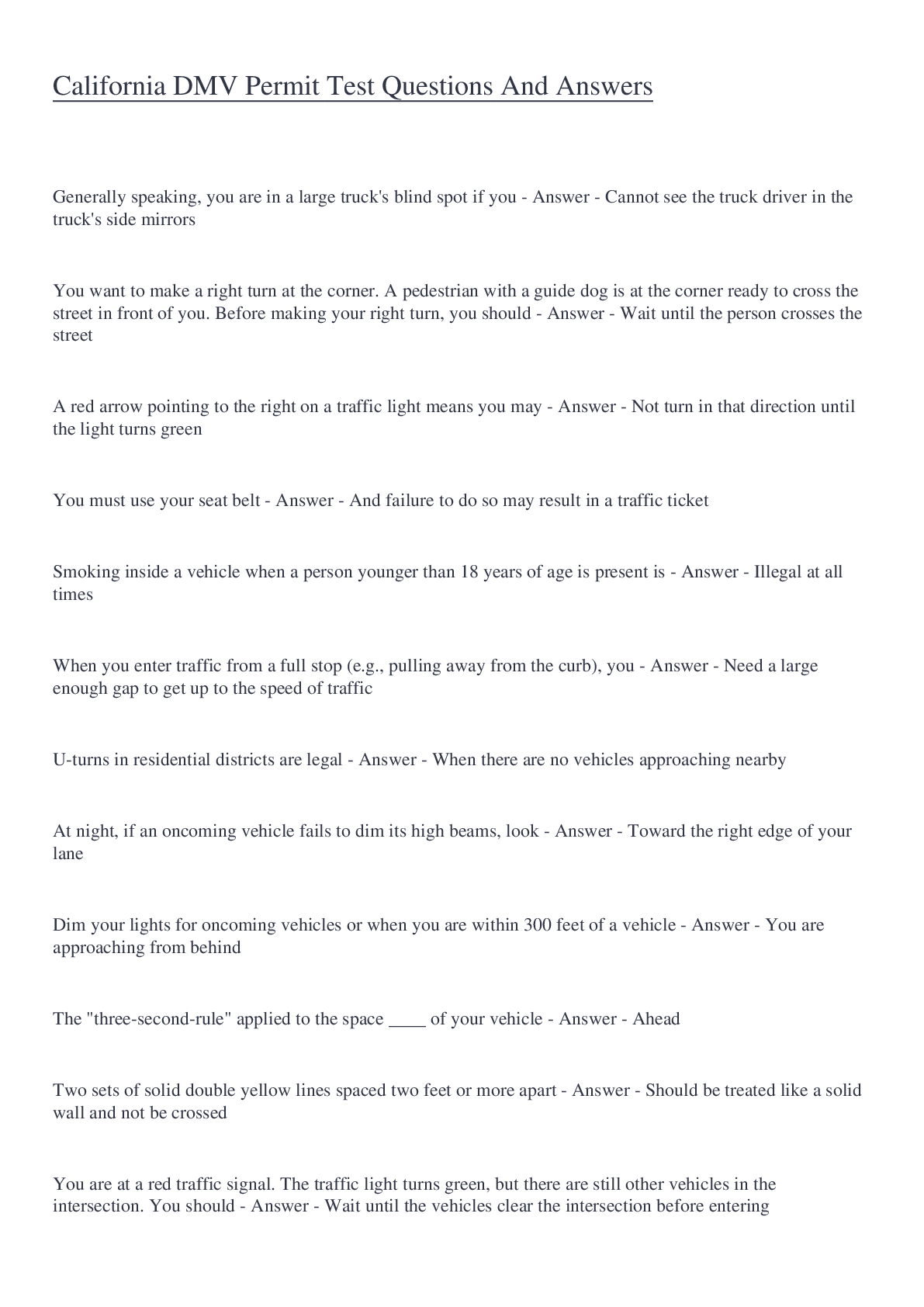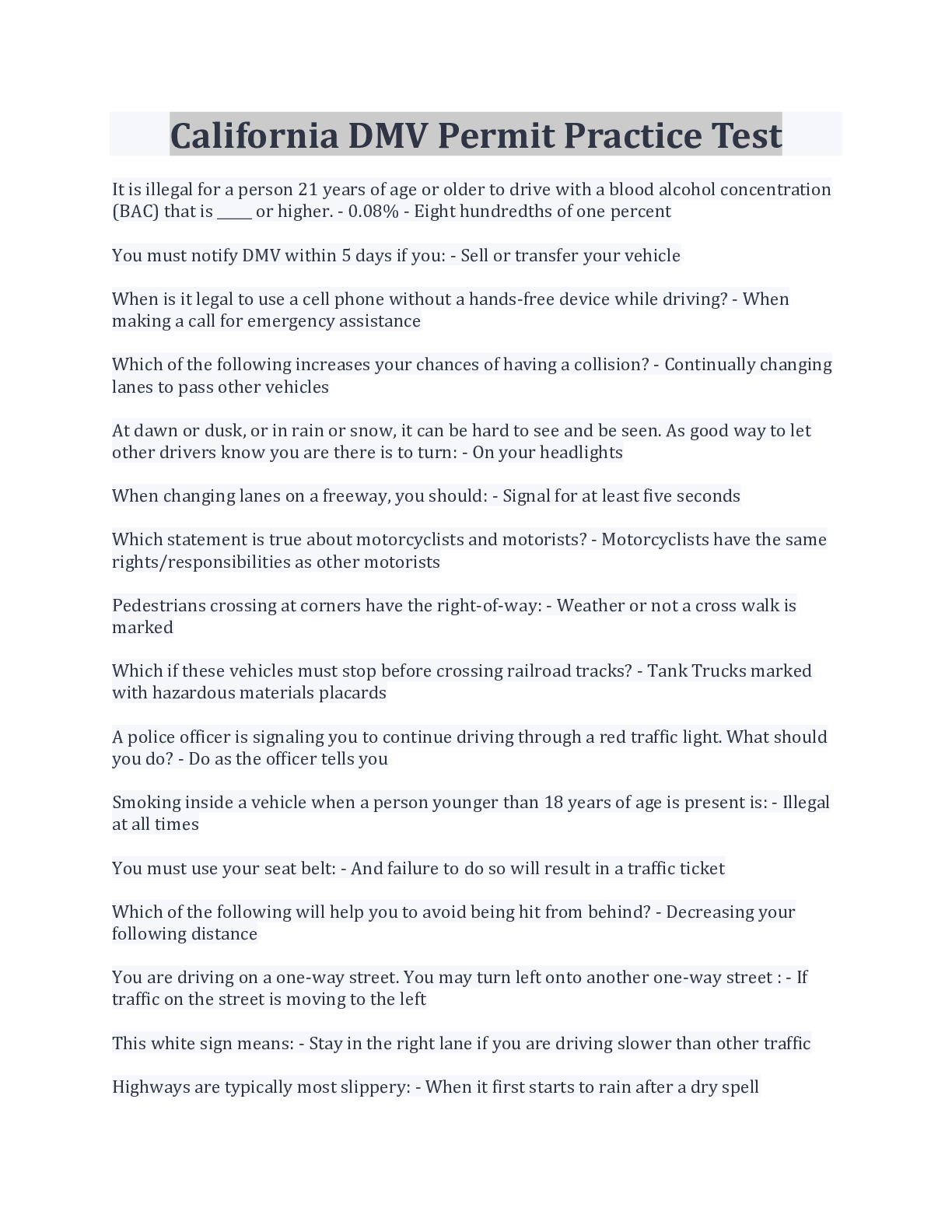*NURSING > QUESTIONS & ANSWERS > MSK 2022 Practice Questions - Full Questions, Answers, & Rationales. 100% proven pass rate. (All)
MSK 2022 Practice Questions - Full Questions, Answers, & Rationales. 100% proven pass rate.
Document Content and Description Below
The correct answer is A: Jumpers knee. Rationale- Patellar tendonitis or Jumpers knee is an overuse injury of the quadriceps tendon. Pain at the lower pole of patella and stiffness after activity ar... e main presentations. Meniscal tear (Option B) presents with popping and locking on movement. Osteochondritis dissecans (Option C) may have pain at base of patella due to traction apophysitis of the tibial tubercle but it is seen in a younger age group who are not skeletal mature. Similarly, Osgood Schlatter (Option D) is seen in younger children aged 12-14. Reference: David J Magee; Orthopedic physical examination edition 6. Page: 770 - ANSA 20 year old college basketball player reports of pain, stiffness and feeling of weakness in his left knee which aggravates after playing. On examination, there is no crepitus, no popping or locking of the joint movement. Palpating the lower pole of patella and quadriceps tendon reproduces pain. What is the MOST likely diagnosis? A. Jumpers knee B. Meniscal tear C. Osteochondritis dissecans D. Osgood Schlatter syndrome The correct answer is A: Strengthening of the right gluteus medius. Rationale- The picture shows the right knee in a valgus position and strengthening of hip abductors muscles will help with proximal stability. Stretching of hip adductors, not strengthening (Option B) will most likely help with knee valgus. Recent evidence suggests strengthening of the right vastus medialis (Option C) does not have any significant effect on knee valgus. Tibialis anterior (Option D) is one joint dorsiflexor and invertor and doesn't cross the knee joint. Reference- Nordin M. Basic Biomechanics of Musculosketelal system, page 148-149 - ANSA PT is evaluating a 24-year-old female basketball player with a vague diagnosis of right knee pain. Thepatient is performing a jump landing as shown in the picture below. The PT treatment should MOST likely focus on: A. Strengthening of the right gluteus medius B. Strengthening of the right adductor magnus C. Strengthening of the right vastus medialis D. Strengthening of the right tibialis anterior The correct answer is C. Apply PA glide on L3 transverse process on the left side. Rationale- Applying a Posterior- Inferior glide will move the L3 vertebrae superiorly and closer to the L2, and help improve the closing restriction. Applying PA glide on L2 transverse process on the right side (Option A) will open the L2-L3 on right side and indirectly close the left side but it is not the best option. Applying PA glide on L3 transverse process on the right side (Option B) will close the L2-L3 on the right side, and applying PA glide on L4 transverse process on the left side (Option D) will close L3-L4 on the left side. Reference: Kisner C, Colby LA; Therapeutic Exercise: Foundations and Techniques, 6th edition Page: 501, 502 - ANSOn examining a patient with a decreased trunk side bending to the left, the physical therapist finds a closing restriction between L2-L3 vertebrae. What is the MOST appropriate intervention to improve the restriction? A. Apply PA glide on L2 transverse process on the right side B. Apply PA glide on L3 transverse process on the right side C. Apply PA glide on L3 transverse process on the left side D. Apply PA glide on L4 transverse process on the left side The correct answer is C: Get a roller bag with wheels, and roll it on the left side. Rationale: Having a roller bag (bag with wheels) on the opposite (left) side will create a counterclockwise torque on the right hip which will help reduce the stress (and pain) on the right hip. Holding the bag without wheels on the left side will increase the stress on the right hip making Aincorrect. Roller bag on the same side (Option B ) will create a clockwise torque, which will also increase stress on the right side. Leaning of the trunk on same side decreases pain, not opposite side (Option D). Reference- Nordin M. Basic Biomechanics of the Musculoskeletal System, Page 219-220 - ANSA 33 year old physical therapy student presents to an outpatient clinic with history of low back pain. The patient walks home each night from the library carrying a heavy bag of NPTE books in his right hand. On examination, the PT notes right hip pain and 3+/5 strength of the right hip abductors. Which of the following is the MOST appropriate suggestion to help alleviate patients symptoms? A. Start carrying the same bag on the left side B. Get a roller bag with wheels, and roll it on the right side C. Get a roller bag with wheels, and roll it on the left side D. Encourage the patient to lean to the left to decrease pain The correct answer is C. Synovitis Rationale- Hypomobility (Option A) has decreased mouth opening but and no pain. Disc displacement with reduction (Option B) has clicking sound. Synovitis (Option C) and Capsulitis (Option D) both have decreased opening but there is no deviation in Synovitis, making option C correct. Reference- Dutton's Orthopaedic Examination; Evaluation, and Intervention, 3rd Edition Page: 1207, 1217, 1220 - ANSA patient presents with limited mouth opening of 25 mm due to pain. There is no complain of clicking sound or mouth deviation when he opens his mouth. The patient is unable to completely close his mouth with teeth clenched together. What is the MOST likely diagnosis based on the patient symptoms? A. Hypomobility B. Disc displacement with reduction C. Synovitis D. CapsulitisThe correct answer is B: Metatarsus adductus, internal tibial torsion, increased femoral anteversion. Rationale- The position of toe-in would correlate with metatarsus adductus (forefoot adducted), internal tibial torsion (position of pronation), and increased femoral anteversion. Reference- Magee DJ; Orthopedic Physical Assessment, 6th edition Page: 715, 897 - ANSA physical therapist is treating a pediatric patient with cerebral palsy. The patient is seen in standing with a toe-in posture. Which of the following postural strategies most accurately correlates with the observed foot position? A. Metatarsus abductus, internal tibial torsion, increased femoral retroversion B. Metatarsus adductus, internal tibial torsion, increased femoral anteversion C. Metatarsal adductus, external tibial torsion, increased femoral retroversion D- Metatarsal abductus, external tibial torsion, increased femoral anteversion The correct answer is D: Soleus. Rationale- Soleus and Gastroc will be stretched during passive ankle dorsiflexion. As Soleus is a one joint muscle which doesn't cross the knee joint, the position of knee shouldn't affect the passive range of motion at the ankle. Good job everyone! Reference- Magee DJ; Orthopedic Physical Assessment, 6th edition Page: 1006 - ANSDuring an outpatient evaluation the PT checks the active and passive ankl [Show More]
Last updated: 1 year ago
Preview 1 out of 23 pages

Reviews( 0 )
Document information
Connected school, study & course
About the document
Uploaded On
May 25, 2022
Number of pages
23
Written in
Additional information
This document has been written for:
Uploaded
May 25, 2022
Downloads
0
Views
77
















